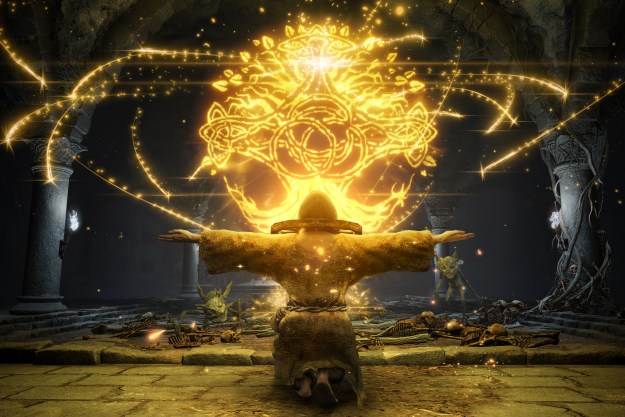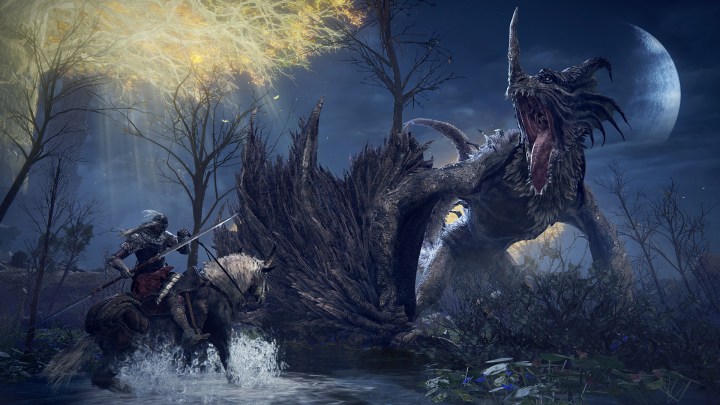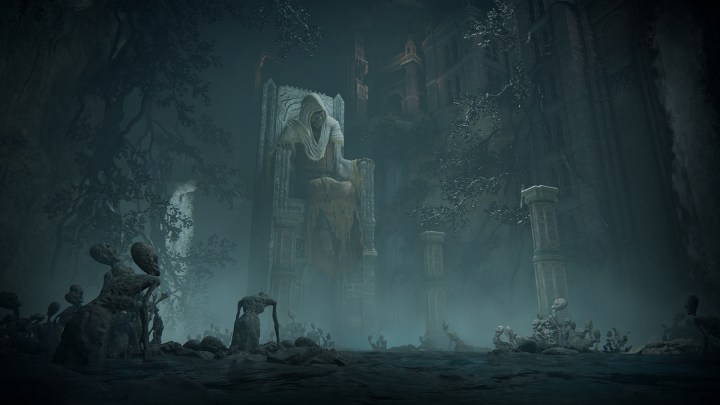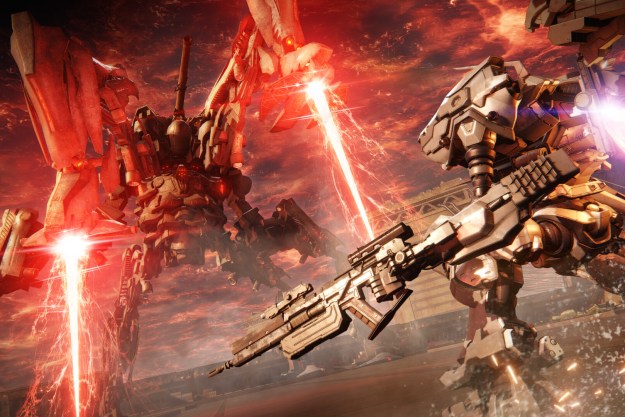
“While technical frustrations hold back its full potential, Elden Ring astonishes with fantastic open-world design and consistently rewarding exploration.”
- Deep combat customization
- Excellent bosses
- Top-tier open world
- Rewarding exploration
- Dazzling art design
- Rough camera
- Frustrating tech quirks
- Disappointing horseback combat
If you have strong feelings about FromSoftware’s games either way, you probably already know what you’ll think of Elden Ring. If you’re a Dark Souls veteran, there’s a fair chance that this takes the throne as your favorite game of all time. For haters who find Souls games tedious and punishing, the praise will sound like a cruel joke. Both sides will have a point.
There’s a good reason that Souls games are so polarizing, and Elden Ring brings the divide into focus. On one hand, it’s an astonishing achievement. The action RPG is frequently mesmerizing, offering the hands down best open-world experience since, you guessed it, The Legend of Zelda: Breath of the Wild. But to give the detractors their due, it’s also a game that demands perfection from players while refusing to clean up the series’ sloppiest quirks.
Don’t let that last part scare you off, though. Despite its lack of finesse,
If you love Dark Souls …

Naturally, combat is the heart of
While
Magic plays a bigger role here than previous Souls games, and it’s a smart move. While
In terms of what you’ll actually be fighting,

For people who love FromSoftware, none of this is new information. Souls games are immensely challenging, but make the struggle worthwhile for curious players.
If you hate Dark Souls …
For those who have never understood the appeal of Dark Souls,
A lot has been made about whether or not these games are “too hard,” but that conversation is a distraction. The real issue is that FromSoftware’s games can often feel too archaic for their own good, adding technical complications on top of gameplay that already requires high skill.

In many of the fights that gave me the most trouble, I felt like I was fighting around sloppy design rather than dueling a powerful boss. The third-person camera is most notably a mess. When fighting large enemies up close, it’s extremely difficult to see what’s going on. In one fight against a hulking magma dragon, the camera closed in so close that I couldn’t see when it was winding up to attack. I just had to roll at random based on loose sound cues.
There’s always a caveat like that in tough fights. One major boss shoots wind projectiles out, which can clip into the floor, making them difficult to see. Another jabs with a huge rapier that pierces through a stone wall as if it’s not there. Memorizing boss patterns is easy; working around unpredictable technical quirks is much harder. That’s before getting into frame stutters and game crashes, which create additional stress.
In many of the fights that gave me the most trouble, I felt like I was fighting around sloppy design rather than dueling a powerful boss.
Even putting the tech issues aside, the game’s insistence on constant challenge creates puzzling inconsistency that makes it tough to read any given situation. Why does a nine-story reptile slashing me with its claws do the same amount of damage as a pipsqueak grunt tossing a pebble at me? That especially sticks out in the open world. In The Legend of Zelda: Breath of the Wild, players can go anywhere, but difficult enemies make it clear when the player is entering a space they aren’t prepared for. Everything, down to the smallest enemy, is powerful in

The list of gripes goes on and on. Stat changes feel like a placebo, as numbers rise with no discernible impact. That makes new systems like Great Runes, which provide temporary stat buffs players get from defeating major bosses, feel superfluous. There’s horseback combat, but it’s a total crapshoot as to whether or not your weapon will actually connect with a foe’s already tricky hitbox.
Souls veterans will learn to live with those quirks, like a teen getting past the taste of cheap beer, but it doesn’t make those issues any easier to digest.
A compromise
That might sound like an extensive list of grievances, but in the spirit of Dark Souls, here’s a surprise: I still love
Much of that comes down to the game’s open world, which is one of the best I’ve ever experienced in a game. Rather than leading players through tight dungeon corridors,
Players could spend dozens of hours exploring, ogling its gothic art, and uncovering secrets before fighting a single enemy.
It’s an intricately designed space filled with breathtaking landscapes, diverse biomes, and no shortage of discoveries. Rather than taking the Ubisoft route and giving players a map full of question marks,
The game’s best strength is that it never railroads players into any set path. When I came up against Stormveil Castle’s difficult final boss, I could simply fast travel out at any time and continue exploring. Hours later, I’d come back several levels stronger with a shiny new weapon I found in an underground ruin and a powerful spell I’d grabbed off a dead guy hanging off the side of a crumbling bridge.

I imagine that
Like previous Souls games,
Our take
Elden Ring is a new gold standard for open-world game design, dishing out some of the best freeform exploration since The Legend of Zelda: Breath of the Wild. Curiosity is rewarded at every turn and secrets truly feel secret. For Souls veterans, the number of tools available adds a new level of depth to its combat that makes constant experimentation worthwhile. Even with those strengths, it’s hard to outright ignore the ugly quirks in FromSoftware’s games, which stick out even more on new tech. A stubbornness to fix archaic issues holds back what should be a once-in-a-generation game, but
Is there a better alternative?
If you want a similarly organic open-world game without the challenge, The Legend of Zelda: Breath of the Wild will be more your speed. Horizon Forbidden West is also comparable in quality if you want a newer release.
How long will it last?
That’s very variable based on how much exploration you do and your skill level, but expect the main story to land around 50 to 60 hours. It feels like there’s over 100 hours of content in total here.
Should I buy it?
Yes. Even if you hate Dark Souls,
Editors' Recommendations
- Xbox, PlayStation, and PC: Is Elden Ring cross-platform?
- Elden Ring: Shadow of the Erdtree finally arrives this June
- How to beat Sea Spider in Armored Core 6
- The best OS Tuning upgrades in Armored Core 6
- The best gear in Armored Core 6





